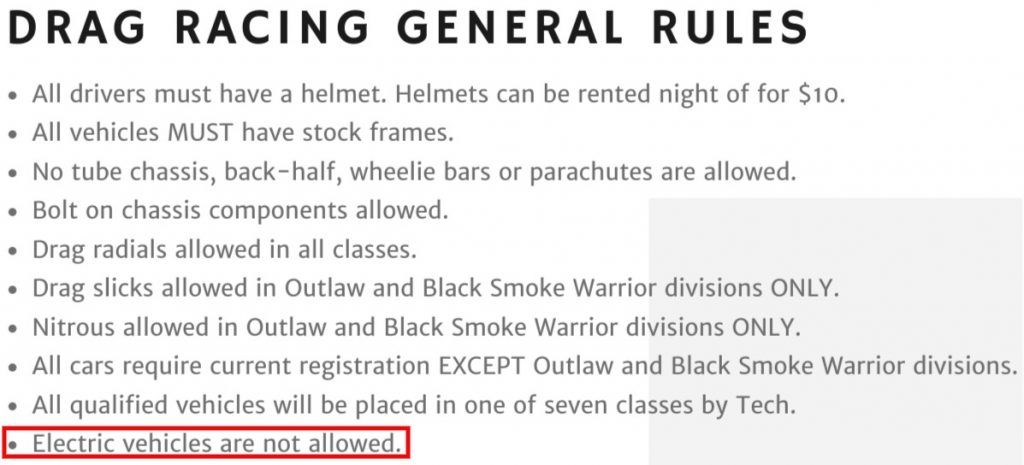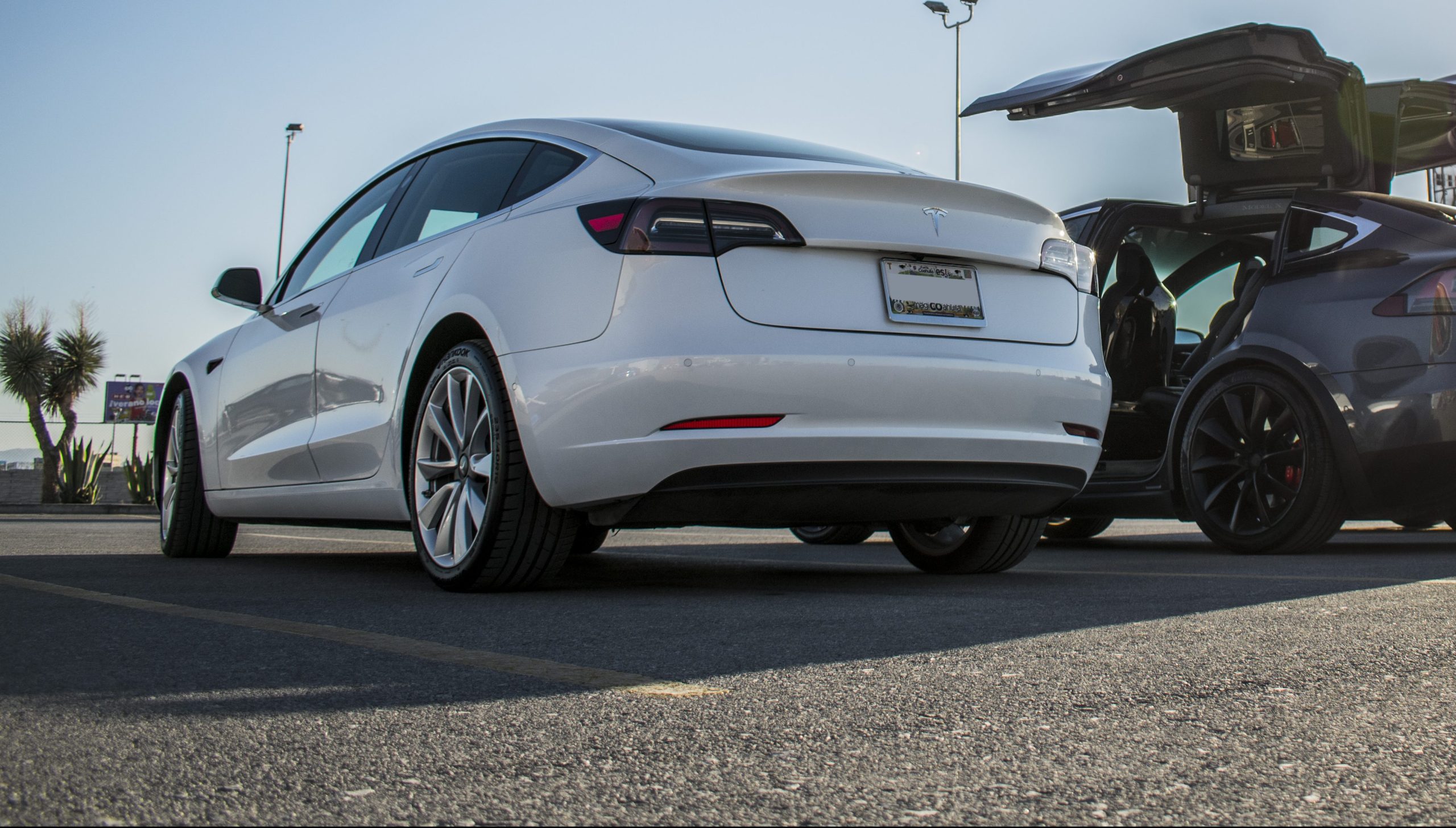The Universal Technical Institute Friday Night Drags event at the Texas Motor Speedway is a celebration of cars that are incredibly quick off the line and dominating in a straight line. The event, which recently held its finals for this season, played host to powerful muscle cars, stunning foreign automobiles, and even large diesel-powered trucks, to name a few.
Amidst the participants in the popular drag racing event, there is one class of vehicles that was notably absent: electric cars. There was no Tesla in sight; not a Model S, Model X, or even a Model 3.
This is due to one of the rules of Friday Night Drags. Looking at the event’s official page, the organizers of the event clearly noted that electric vehicles are prohibited from competing in the drag races. “Electric vehicles are not allowed,” the organizers wrote.

This is quite a shame, considering that electric vehicles, particularly Tesla’s Performance-branded cars, have developed a reputation for being incredibly formidable in straight-line races. The Model S P100D, particularly the “Raven” iterations of the vehicle, is downright deadly in the quarter-mile, beating supercars on a regular basis. The Model 3 Performance, a four-door family car, has even beaten a Ferrari 458 in a 1/8 mile race.
A look at past winners of Friday Night Drags show vehicles that have traded blows with Teslas in the past, including the Nissan GT-R, the Chevrolet Corvette, and the Ford Mustang. As such, it almost seems like the event was lacking a popular, recognizable competitor due to the absence of America’s all-electric muscle cars.
Addressing the event’s strict No-EV rule, Texas Motor Speedway VP of Public Relations David Hart explained that electric cars such as Teslas could crash and catch fire in the event, which would be difficult to put out. Crashes with gas and diesel-powered cars and trucks could also happen, but it is far easier to extinguish gas fires than those resulting from batteries. Unfortunately for EV owners, the speedway’s emergency vehicles are not equipped to handle electric car fires.
“The reason for the exclusion is, in the event of a crash and possible resulting fire, our emergency vehicles currently do not carry the specific equipment required to suppress EV fires. As I’m sure you’re aware, conventional extinguishers are of no use in fighting lithium-ion battery fires,” Hart noted in a statement to Teslarati.
It should be noted that Teslas are actually 8x less likely to catch fire than their internal combustion engine-powered counterparts. As mentioned by the electric car maker in its most recent quarterly safety report, data from 2012-2018 shows that there was approximately one Tesla vehicle fire for every 170 million miles traveled. In comparison, the National Fire Protection Association (NFPA) and the US Department of Transportation listed one vehicle fire for every 19 million miles traveled.
One could only hope that events such as Texas Motor Speedway’s Friday Night Drags would eventually open their doors to electric vehicles in the near future. The era of EVs being grossly inferior to the internal combustion engine, after all, has definitively ended. This is especially true since Friday Night Drags uses a 1/8-mile strip, which is pretty much Tesla territory at this point.

News
Tesla China delivery centers look packed as 2025 comes to a close
Needless to say, it appears that Tesla China seems intent on ending 2025 on a strong note.

Tesla’s delivery centers in China seem to be absolutely packed as the final days of 2025 wind down, with photos on social media showing delivery locations being filled wall-to-wall with vehicles waiting for their new owners.
Needless to say, it appears that Tesla China seems intent on ending 2025 on a strong note.
Full delivery center hints at year-end demand surge
A recent image from a Chinese delivery center posted by industry watcher @Tslachan on X revealed rows upon rows of freshly prepared Model Y and Model 3 units, some of which were adorned with red bows and teddy bears. Some customers also seem to be looking over their vehicles with Tesla delivery staff.
The images hint at a strong year-end push to clear inventory and deliver as many vehicles as possible. Interestingly enough, several Model Y L vehicles could be seen in the photos, hinting at the demand for the extended wheelbase-six seat variant of the best-selling all-electric crossover.
Strong demand in China
Consumer demand for the Model Y and Model 3 in China seems to be quite notable. This could be inferred from the estimated delivery dates for the Model 3 and Model Y, which have been extended to February 2026 for several variants. Apart from this, the Model Y and Model 3 also continue to rank well in China’s premium EV segment.
From January to November alone, the Model Y took China’s number one spot in the RMB 200,000-RMB 300,000 segment for electric vehicles, selling 359,463 units. The Model 3 sedan took third place, selling 172,392. This is quite impressive considering that both the Model Y and Model 3 are still priced at a premium compared to some of their rivals, such as the Xiaomi SU7 and YU7.
With delivery centers in December being quite busy, it does seem like Tesla China will end the year on a strong note once more.
News
Tesla Giga Berlin draws “red line” over IG Metall union’s 35-hour week demands
Factory manager André Thierig has drawn a “red line” against reducing Giga Berlin’s workweek to 35 hours, while highlighting that Tesla has actually increased its workers’ salaries more substantially than other carmakers in the country.

Tesla Giga Berlin has found itself in a new labor dispute in Germany, where union IG Metall is pushing for adoption of a collective agreement to boost wages and implement changes, such as a 35-hour workweek.
In a comment, Giga Berlin manager André Thierig drew a “red line” against reducing Giga Berlin’s workweek to 35 hours, while highlighting that Tesla has actually increased its workers’ salaries more substantially than other carmakers in the country.
Tesla factory manager’s “red line”
Tesla Germany is expected to hold a works council election in 2026, which André Thierig considers very important. As per the Giga Berlin plant manager, Giga Berlin’s plant expansion plans might be put on hold if the election favors the union. He also spoke against some of the changes that IG Metall is seeking to implement in the factory, like a 35-hour week, as noted in an rbb24 report.
“The discussion about a 35-hour week is a red line for me. We will not cross it,” Theirig said.
“(The election) will determine whether we can continue our successful path in the future in an independent, flexible, and unbureaucratic manner. Personally, I cannot imagine that the decision-makers in the USA will continue to push ahead with the factory expansion if the election results favor IG Metall.”
Giga Berlin’s wage increase
IG Metall district manager Jan Otto told the German news agency DPA that without a collective agreement, Tesla’s wages remain significantly below levels at other German car factories. He noted the company excuses this by referencing its lowest pay grade, but added: “The two lowest pay grades are not even used in car factories.”
In response, Tesla noted that it has raised the wages of Gigafactory Berlin’s workers more than their German competitors. Thierig noted that with a collective agreement, Giga Berlin’s workers would have seen a 2% wage increase this year. But thanks to Tesla not being unionized, Gigafactory Berlin workers were able to receive a 4% increase, as noted in a CarUp report.
“There was a wage increase of 2% this year in the current collective agreement. Because we are in a different economic situation than the industry as a whole, we were able to double the wages – by 4%. Since production started, this corresponds to a wage increase of more than 25% in less than four years,” Thierig stated.
News
Tesla is seeing a lot of momentum from young Koreans in their 20s-30s: report
From January to November, young buyers purchased over 21,000 Teslas, putting it far ahead of fellow imported rivals like BMW and Mercedes-Benz.

Tesla has captured the hearts of South Korea’s 20s-30s demographic, emerging as the group’s top-selling imported car brand in 2025. From January to November, young buyers purchased over 21,000 Teslas, putting it far ahead of fellow imported rivals like BMW and Mercedes-Benz.
Industry experts cited by The Economist attributed this “Tesla frenzy” to fandom culture, where buyers prioritize the brand over traditional car attributes, similar to snapping up the latest iPhone.
Model Y dominates among young buyers
Data from the Korea Imported Automobile Association showed that Tesla sold 21,757 vehicles to the 20s-30s demographic through November, compared to BMW’s 13,666 and Mercedes-Benz’s 6,983. The Model Y led the list overwhelmingly, with variants like the standard and Long Range models topping purchases for both young men and women.
Young men bought around 16,000 Teslas, mostly Model Y (over 15,000 units), followed by Model 3. Young women followed a similar pattern, favoring Model Y (3,888 units) and Model 3 (1,083 units). The Cybertruck saw minimal sales in this group.
The Model Y’s appeal lies in its family-friendly SUV design, 400-500 km range, quick acceleration, and spacious cargo, which is ideal for commuting and leisure. The Model 3, on the other hand, serves as an accessible entry point with lower pricing, which is valuable considering the country’s EV subsidies.
The Tesla boom
Experts described Tesla’s popularity as “fandom culture,” where young buyers embrace the brand despite criticisms from skeptics. Professor Lee Ho-geun called Tesla a “typical early adopter brand,” comparing purchases to iPhones.
Professor Kim Pil-soo noted that young people view Tesla more as a gadget than a car, and they are likely drawn by marketing, subsidies, and perceived value. They also tend to overlook news of numerous recalls, which are mostly over-the-air software updates, and controversies tied to the company.
Tesla’s position as Korea’s top import for 2025 seems secured. As noted by the publication, Tesla’s December sales figures have not been reported yet, but market analysts have suggested that Tesla has all but secured the top spot among the country’s imported cars this year.










